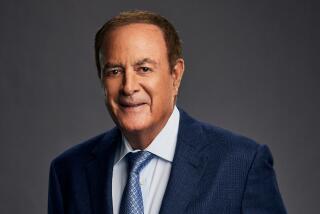Missionary for Turner TV : Scott Sassa Sees Cable as the Future of Television
- Share via
In only its second year of operation, TNT this year won six ACE Awards, cable television’s highest honor, including best original cable movie of the year.
TNT is also the home of both NFL and NBA games. But what has really given the cable channel an air of legitimacy in Hollywood is the Sunset Boulevard billboard that hypes its original movies alongside huge ads trumpeting the recent offerings from Universal, Paramount, Fox and Warner Bros.
“It may sound silly, but that billboard has really helped us,” said Scott Sassa, president of Turner Entertainment Networks, on the way to a meeting with entertainment managers. “It’s really helped give us a high profile within this industry.”
Sure enough, as soon as he begins his TNT sales pitch, a manager says: “Oh yeah, we’re very familiar with what you do. Your billboard is smack outside our office window.”
Building legitimacy for Ted Turner’s TNT and TBS channels in particular and cable in general is Sassa’s mission. At 32, he’s sort of a new breed of TV executive, one who has to figure out not only what newfangled program in what time period is going to lure the most viewers to his network, but also what combination of Hollywood stars, professional sports and big-billboard quality programming is going to compel the average TV viewer to sign up for cable.
As a business, cable has an advantage over network television, Sassa says. While the networks derive revenue solely from advertising revenue, cable makes money both from ad sales and from fees derived from each cable subscriber’s monthly payments. TNT, for example, claims a monthly fee of about 37 cents for each cable subscriber. Therefore, to Sassa, attracting new subscribers to cable is as important as bringing viewers to his own networks.
So far, Sassa has succeeded at both tasks. Today, about 56 million of the 93 million television homes nationwide are wired for cable, up about 6 million, or 12% over pre-TNT levels. And in 1990, the viewing audience for basic cable was up 20% over the previous year, pushed especially by TNT’s 90% ratings increase. Spurred primarily by TNT’s growth, TNT and TBS together reported a 72% increase in revenues last year, to $663 million.
Such surges are a harbinger of millions, even billions, to come, Sassa says. The trick is to continue making cable channels attractive so current subscribers maintain their service and non-subscribers want to hook up.
Sassa is a walking, breathing billboard for TNT, TBS and the entire cable industry. Young and energetic, he is equally at home talking plot points with movie stars like Faye Dunaway as he is devising detailed business plans with pin-striped number crunchers.
According to Peter Dekom, one of Hollywood’s most powerful and well-connected attorneys, Sassa is at the top of a short list of young TV executives destined to lead the industry for decades to come.
High praise for an Asian-American kid from Torrance who was going to be a banker until an internship at Smith Barney during his final semester at USC “bored” him right out of high finance. About that time, Sassa read a newspaper article about “baby moguls,” Hollywood executives who had achieved remarkable success at a young age. Since his father had died at 31, Sassa was motivated to succeed quickly, and the article told him that the entertainment business was a world where he could make his mark fast.
Sassa finagled a job as an assistant to Warren Cowan, one of Hollywood’s top public-relations gurus, but nine months into the job, he realized PR was not for him either. A fellow USC alum then offered Sassa a job at Turner in 1982.
“I had just gotten cable in my apartment,” Sassa remembers, “but I didn’t know anything about it. I mean, MTV had just started, and I said to this guy, ‘I want to be in the entertainment industry (but) I’m not going to move to Atlanta and ruin my career.’ Then I went to a cable show and I saw Ted (Turner) speak and I was captivated by him and the whole idea of cable.”
Sassa’s first job was director of sales promotion, but he quickly realized that at Turner, he could stick his hand into just about every pot. He created the music-video show “Night Tracks” for TBS, helped put together the numbers for Turner’s attempts to buy CBS and MGM, and he was in on the planning of a never-realized prototype for a fourth TV network.
Sassa was then asked to create a music-video network to rival MTV. His “baby” went on the air in three months and went off the air 45 days later when MTV bought it out.
“I thought I was a 25-year-old failure who would never work in this town again,” Sassa said. He moved back to Los Angeles and found a job as the Playboy Channel’s vice president of programming. But Jaime Kellner, chairman of Fox Broadcasting, remembered Sassa from the presentation he had made about starting a fourth network at Turner a few years back, and Kellner hired him to help Fox launch a fourth television network.
Sassa lasted two years at Fox before overwork, exhaustion and company infighting took its toll. His confidence reshaken, Sassa quit and took a job at Ohlmeyer Communications, an independent television production company. But when Jerry Hogan, his old boss at Turner, called to pitch a new cable venture called TNT, Sassa was again caught under the Turner spell.
The remarketing of cable began in the late 1980s, Sassa says, when industry executives started to fret over the fact that the number of subscribers had reached a plateau. While about half the country was hooked on cable’s news, sports, music videos and pay-service programs, the other half was saying, “I can live without that.”
To non-subscribers, cable was little more than a dusty warehouse of old network reruns. To rise above the 50-million subscriber level of 1988, cable needed to offer something new.
TNT was launched in October, 1988. It used the Turner-owned MGM library of films as its base and then slowly began adding original movies and major sporting events. HBO and other pay-cable services had been offering original programming on cable for many years, but to see those programs, viewers had to pay an additional fee. TNT’s goal was to offer similar programs for only the price of the monthly cable hookup.
“But we couldn’t do it on the cheap,” Sassa said. “Cable had always been guilty of spending a buck and a half on its shows. But the viewer doesn’t care that we don’t have the money to compete with network programming. We can’t run a written crawl on the screen that says, ‘Forgive us, we’re only cable and we only had half the money to make this.’
“So we had to spend the money and we had to do it big. The goal was to get our movie on the cover of TV Guide. Now, I’m not living in a fantasy world that someone will walk through the checkout line at the market and see Farrah Fawcett on the cover of TV Guide talking about (her cable movie) and say, ‘Oh, my God, I have to subscribe.’ But it serves as a trigger for them to rethink cable. They might go, ‘Well, my friends are always talking about CNN and the kids are always bugging me about MTV.’ And now we (at TNT) have the NBA and the NFL, and the cumulative effect makes cable sexier and more exciting.”
TNT spends 80% of its budget on programming, including the production of about 24 original movies each year, at an average cost of $3 million each. The latest, a Louis L’Amour Western called “Conagher,” airs tonight (see accompanying review).
So far, TNT’s most notable and popular movies include: Faye Dunaway in “Cold Sassy Tree,” Farrah Fawcett in “Margaret Bourke-White” and “Heat Wave,” the ACE-winning drama about the Watts riots.
But original movies, even with big name stars, were not enough to lure enough new subscribers to cable, or even to induce cable operators, whose systems are already crowded with myriad cable choices, to include TNT in their lineup.
“No one is going to call up their cable operator and say, ‘Hey, I couldn’t get that Farrah Fawcett movie the other night,” Sassa says, almost embarrassed to admit it. “But with NBA basketball or the NFL, those people will call up and say, ‘Hey, Where’s my game?’ ”
The result: Originally available in only 17 million homes, TNT is now seen in more than 53 million.
Still, Sassa concedes that no matter how much money TNT and TBS make, they will probably never match the impact in terms of total viewers that the Big 3 enjoy. But then again, if he worked for a broadcast network, he wouldn’t be able to enjoy the variety of a day in which he negotiated with the NBA about adding another basketball game to the TNT lineup, discussed budgets with his controllers, tried to figure out a promotable way to package a bunch of old movies, explored ways to release one of TNT’s movies theatrically, and got a kiss on the cheek from Faye Dunaway when she dropped by to pitch him on a new project.
“Cable is the right place for me right now,” Sassa concluded. “It is healthy; it is really starting to emerge. In my lifetime, network television will probably always be bigger than cable. But network television is not going to grow anymore. It’s all a matter of cutting back and trying to control the bottom line. The network business plan was created in the 1960s when no one dreamed of all this competition. Our business plan was developed in 1980. It makes more sense.”
More to Read
The biggest entertainment stories
Get our big stories about Hollywood, film, television, music, arts, culture and more right in your inbox as soon as they publish.
You may occasionally receive promotional content from the Los Angeles Times.










